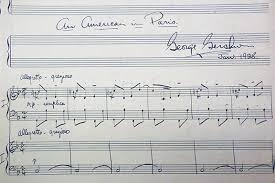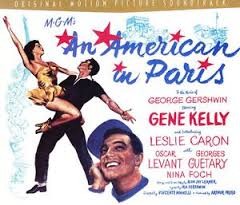Nick
Catalano is a TV writer/producer and Professor of Literature
and Music at Pace University. He reviews books and music for
several journals and is the author of Clifford
Brown: The Life and Art of the Legendary Jazz Trumpeter,
New York
Nights: Performing, Producing and Writing in Gotham
and A
New Yorker at Sea. His latest book, Tales
of a Hamptons Sailor, is now available. For Nick's
reviews, visit his website: www.nickcatalano.net
An
American in Paris: Creation, Authorship and Attribution

In
1928, at the height of his astounding orchestral music career,
Brooklyn-born George Gershwin created and scored the iconic
tone poem An American in Paris for the standard instruments
of a symphony orchestra plus celesta, saxophones and automobile
horns. He said “My purpose here is to portray the impression
of an American visitor in Paris as he strolls about the city
and listens to various street noises and absorbs the French
atmosphere.”
Intrigued
with the unusual chord structures of Maurice Ravel, Gershwin
had come to Paris to study with him and began a lengthy relationship
with the French master. During his stay he met often with the
legendary teacher Nadia Boulanger who encouraged him to "be
himself" and continue with the jazz-inspired approach he
had developed in his orchestral compositions. He initially wrote
the piece for his Paris hosts Robert and Mabel Shirmer and described
it as "a rhapsodic ballet." The 18-minute tour de
force introduces 3 haunting melodic strains which have resonated
throughout the entire corpus of pop music repertoires, movie
themes, cabaret acts, dance recitals and TV commercials for
almost 90 years. The piece is a masterpiece for the ages.
For
its first 25 years, if you asked most people anywhere to identify
An American in Paris they would naturally respond that
it was a music written by George Gershwin who had tragically
died at age 38 -- about ten years after he wrote the piece.
But then in 1951 at the height of  the
movie musical era, MGM released a film entitled An American
in Paris starring Gene Kelly and Leslie Caron directed
by Vincente Minelli with a screenplay by Alan Jay Lerner. The
film won the Academy Award for best picture and, at that point,
began to replace Gershwin's tone poem in everyone's mind as
the work An American in Paris.
the
movie musical era, MGM released a film entitled An American
in Paris starring Gene Kelly and Leslie Caron directed
by Vincente Minelli with a screenplay by Alan Jay Lerner. The
film won the Academy Award for best picture and, at that point,
began to replace Gershwin's tone poem in everyone's mind as
the work An American in Paris.
Although
the film was totally constructed around Gershwin's music (he
and his lyricist brother Ira dutifully received credits) the
movie took center stage in all the critical commentary. Because
of Lerner's successful romantic screenplay, the film enraptured
world audiences; the love story of Jerry Mulligan (Gene Kelly)
and Lise Bouvier (Leslie Caron), the exciting scenes of Paris,
and the amazing Kelly- choreographed dance numbers quickly became
the doppelganger of the work An American in Paris.
Jerry
Mulligan is an ex-G.I. who decided to remain in Paris after
WWII to pursue a career as an artist. He pals around with fellow
American Adam Cook (Oscar Levant), a struggling concert pianist,
who humorously dreams he is performing Gershwin's Concerto
in F for a gala audience in a concert hall. Jerry meets
Lise Bouvier working at a parfumerie and instantly falls in
love with her. Although betrothed to singer Henri Baurel (George
Guetary) in a filial-like relationship stemming from a childhood
idol worship, Lise, initially spurning Jerry, finally agrees
to meet him for a romantic evening stroll along the Seine. Lise
and Jerry instantly bond in a song and dance musical sequence
("Our Love is here to Stay") that unhinges the audience
and will become the apotheosis of romance in cinematic history.
The obligatory conflict that Lise has because of her betrothal
to Henri is resolved and, of course, she and Jerry walk off
into the sunset in the end. But not before the film pauses to
include a 17- minute dream ballet sequence (unheard of in a
commercial film) featuring Kelly and costing some $450,000.
The
film, with its spectacular stars, romantic screenplay and lavish
dance sequences was a huge success and, in the decades that
followed, all but obliterated Gershwin's original tone poem
in the collective unconscious. When the title "An American
in Paris" came up in sophisticated party conversation,
people marveled over Kelly's dancing, Caron's screen presence,
and, the wonderful Gershwin songs: “I Got Rhythm,”
“S'Wonderful,” “Embraceable You,” etc.
Commentary about the genius of his original symphonic tone poem
all but disappeared.
Since
1951 this film has enjoyed another life as a TV movie staple
receiving new plaudits. On such showcases as Turner Classic
Movies, commentators ooh and aah about Gene Kelly and his marvelous
choreography, Leslie Caron's film debut (which initiated a hugely
successful career) and the MGM geniuses who ran the studio during
those golden years. But, once again, hardly a word is uttered
in praise of the original Gershwin composition. As a result
millions of baby boomers and others have grown up thinking that
the film An American in Paris had no former identity
and as such the film creators deserve all of the kudos for its
existence.
In
2015 Broadway producers announced the arrival of a new show
dubbed An American in Paris. The Playbill program for
the show states that it is a "new musical" and that
its creation was "inspired by the motion picture”
(of 1951). This show was heralded by the critics for the ‘classical’
ballet style dance sequences of its director/choreographer Christopher
Wheeldon who won the Tony award for his efforts.
This
new musical has a book by writer Craig Lucas who makes unfortunate
changes to Lerner's screenplay. He locates the action back to
the 1945 period at the end of the war to facilitate a B story
about the horror of Hitler's final solution, he changes Lise's
last name to Dassin, and he restructures her relationship with
Henri Baurel to include conflicts involving his parents. None
of this writing improves upon Lerner's book.
The
show deletes five of the tunes that were in the motion picture
and actually adds nine new songs that were never in the film.
George Gershwin's name appears in the ‘Who's who in the
cast’ section of the Playbill with a brief, curious write-up
noting some of his compositions and the fact that he died of
a brain tumor when not quite 39. One wonders what a young reader
not acquainted with the name George Gershwin will think about
this hurried insertion. Certainly, no hint of the titanic genius
originally associated with the work An American In Paris
could be garnered by any such reader.
One
critic uses the term "re-imagined" to describe the
naissance of this new musical. It is a useful term but it focuses
on the relationship between the 1951 film and this 2015 Broadway
show while ignoring the original Gershwin composition.
This
isn't the first time that Gershwin's creations have been slighted.
Some may recall that in 2012 another Gershwin opus, Porgy
and Bess, was ‘re-imagined’ and brought to
Broadway by director Diane Paulus and playwright Suzan- Lori
Parks. In this production, much of the action of the George
and Ira Gershwin-DuBose and Dorothy Heyward folk opera was altered.
The team of ‘re-imaginers’ added new scenes, invented
biographical details, changed dialogue, and even contemplated
a new ending. And this production titled The Gershwins’
Porgy and Bess was actually sanctioned and approved by
the Gershwin and Heyward estates.
Controversy
was immediate initially launched by Stephen Sondheim (c.f. New
York Times, Aug. 10, 2011) who thankfully raised objections
about the ‘re-imagining’ process. In the end, although
the show was voted a best revival award, no Tony nominations
or awards were given for rewrites or reimaginings.
The
process of borrowing the genius of Gershwin by creating work
that cannot possibly be accomplished without his opuses and
overshadowing his creativity with new ‘re-imaginings’
does injustice to his legacy. It deprives new generations of
students accurate access to his accomplishments and distorts
the nature of his oeuvre.
The
problem of creative attribution, dubious borrowings, re-imaginings,
and out-and-out thievery is vast. There will always be those
who come along wishing to aggrandize themselves by some kind
of association with a great artist. A famous instance occurred
when, in the 19th century, so-called scholars, writers and professors
began to claim that Shakespeare wasn’t the author of Hamlet,
Othello etc. And if the Bard of Avon can be a victim of
this attribution deformation habit -- anyone can.